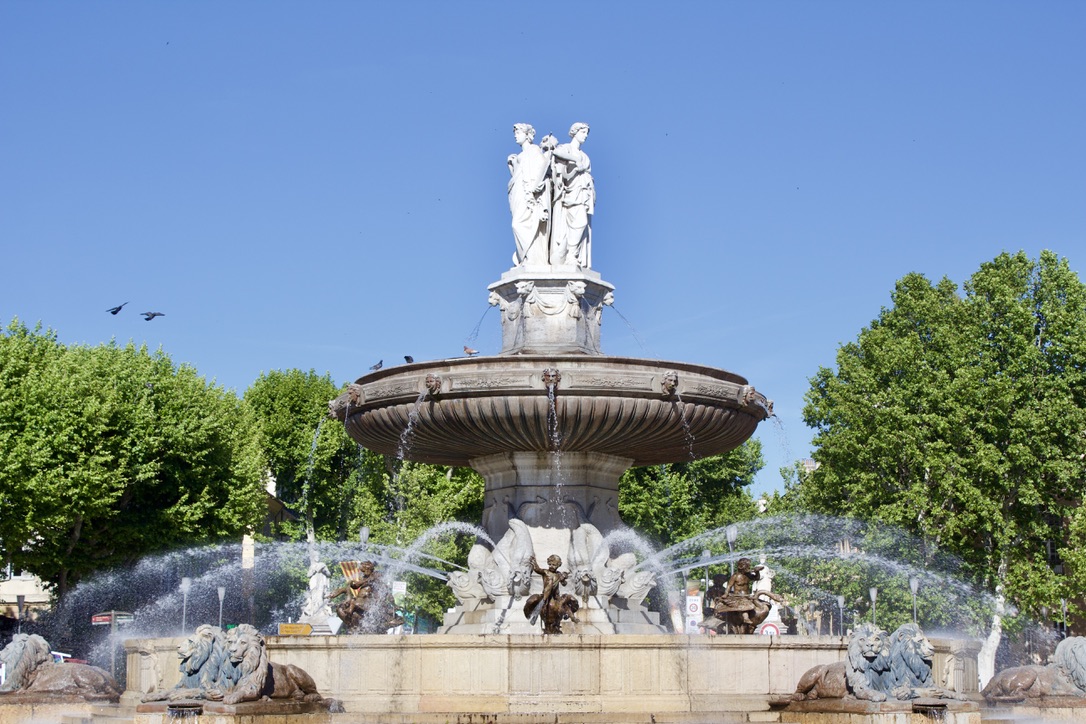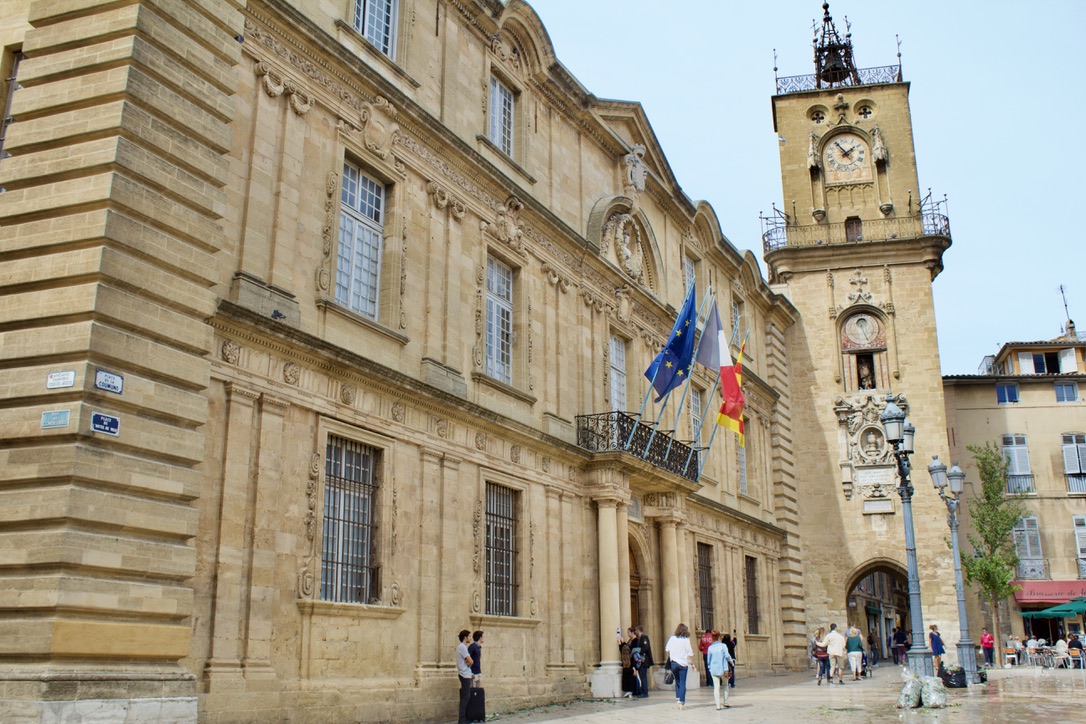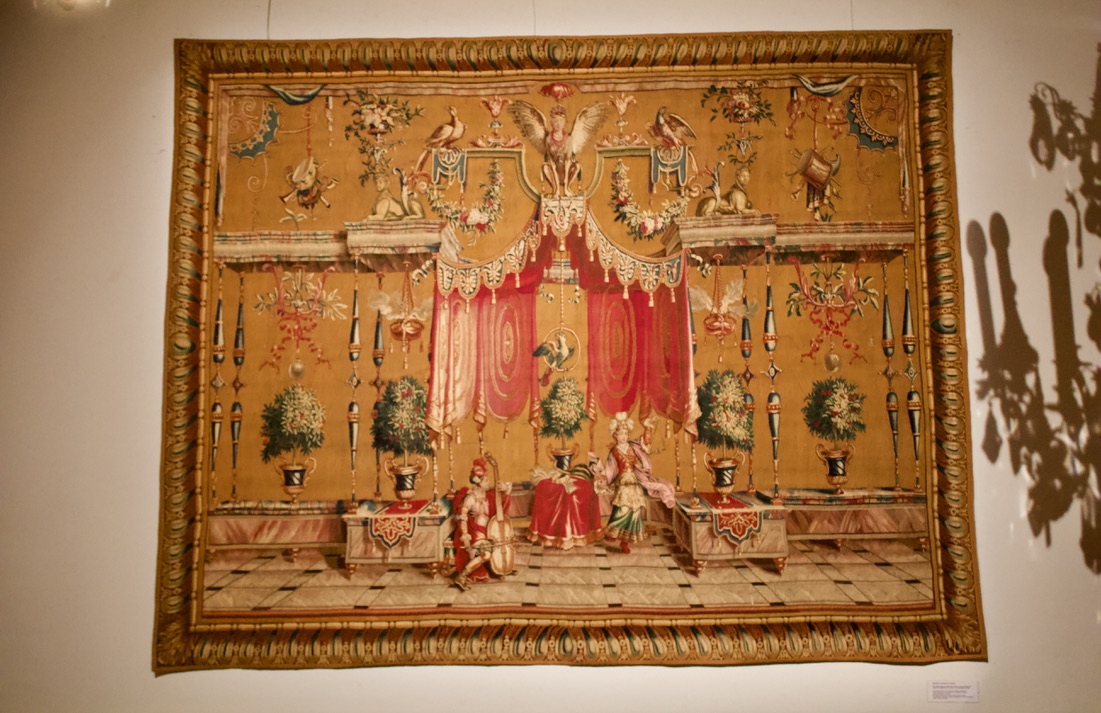AIX-EN-PROVENCE - CAPITAL OF PROVENCE
Aix-en-Provence is located 145 kilometers from Cannes between Saint Victoire and Trévaresse chain of mountains in the Bouches-du-Rhône department of Provence-Alpes-Côte d'Azur region. The city has a rich historical and architectural heritage from the Roman Empire, the Medieval period and the Renaissance.

Having served as the capital of Provence for more than 500 years, from the 12th through the 18th centuries, the city of Aix-en-Provence is a thriving modern metropolis, featuring many beautiful historical buildings which line the streets of the city center.
Among the structures built during the 17th century are the Town Hall and its Clock Tower, the Place des Quatre-Dauphins, located in the heart of the Mazarin district, as well as the villa of Boisgelin and the villa of Baron de Saizieu.

Others notable buildings such as the villa of Caumont (now the Art Center), the Estienne-de-Saint-Jean villa and the villa of Castillon were built in the 18th century.
Aix-en-Provence is also known as academic center : starting from 1409 universities of letters, law, economics, political science, arts and crafts, fine arts, and the school of medicine are founded here.
The city Aix-en-Provence is particularly renowned for its artistic and cultural heritage where its museums contain rich collections of artistic and historical objects gathered up by parliamentarians during the 17th and 18th centuries to decorate their villas.
Moreover, the free drawing school was inaugurated in 1766 at the Bourbon Collège (now High School of Sacré Cœur) and the first public exhibition of the Fauris of Saint Vincent collection took place at the Town Hall in 1824. During the period 1825-1838, the museum and drawing school were transferred to the former Malta priory located in the Mazarin aristocratic district. It was officially inaugurated and opened to the public in 1838.
Among the important personalities born in Aix-en-Provence are Paul Cézanne and Emile Zola. While Emile Zola spent only the first eighteen years of his life in Aix-en-Provence, Paul Cézanne has spent his whole life in the city and its surroundings and greatly contributed to the development of its influence and fame. Nearly 120 of his works are dedicated to the theme of Provence.
Each year, the city organizes an international lyric art festival.
SAINT-VICTOIRE AND CÉZANIAN LOCALES - "WORLD HERITAGE SITE" BY UNESCO
The Sainte-Victoire mountain and the Cézanian locales are among the UNESCO designated world heritage sites. The quarries of mountain are at the origin of the famous pink marble, which is particularly appreciated as material for the construction of local villas. Such materials were also used in the pedestals of the leonine sculptures of the Rotonde fountain in Aix-en-Provence. The Sainte-Victoire mountain is also recognized as a special protection area: among the many animal species, there are also a wide variety of birds, some protected, such as the golden eagle, the great duke of Europe, the warbler pitchou, the bunting ortolan.
Some historical monuments are located on or at the foot of the mountain. Dating from 1875, the "cross of Provence" is a noteworthy landmark situated on the massif. This one, 19 meters high, was placed on a peak of 946 meters overlooking the chapel Notre Dame de la Victoire and a priory of the 17th century. The Notre Dame de la Victoire chapel is located at an elevation of 885 m. Adjacent to the chapel, the former priory, recently restored, is open to the public free of charge year round. At the foot of the south face of mountain, in the small village of Saint-Antonin-sur-Bayon is located a bastide with its parochial buildings dating from the 18th century. The village also has a Romanesque chapel dating from the 11th century which was restored in 2011.
A little further east on the south face, one can find the chapel of Saint-Ser, completely restored in the early 2000s. In the south-west from the Croix de Provence, is situateed the former hamlet of the Trou, right next to the Cézanne refuge.
Finally, the oppidum of Untinos, above Saint-Antonin, was inhabited at various times (Celtic-Ligurian, ruins of the Old Castle) and probably served as a lookout during Roman times.
We can also see the remnants of a remarkable aqueduct which goes from Saint-Antonin to Aix, and which carried the waters of the Sainte-Victoire towards Aix. The castle of Vauvenargues, dating from the 14th century, and various bastides are located at the foot of the north slope.
Several masters of painting took the Montagne Sainte-Victoire as a subject: Granet, Cézanne, Wassily Kandinsky, Auguste Renoir. Granet has often placed the Sainte-Victoire in the background of its Aixois landscapes. Paul Cézanne dedicated nearly eighty of his works only to the Sainte-Victoire.
AIX-EN-PROVENCE: FOUNDATION OF A CITY
The foundation of the Roman colony at Aix-en-Provence is dated to the 1st century BC. It follows the call for help launched by the Greeks of Massalia (Marseille) who were in permanent conflict with the Ligurian and Gallic tribes of the region. In order to protect the commercial route between Rome and Massalia, the consul Gaius Sextius Calvinus set up a city called Aquae Sextiar which can be translated as "Waters of Sextius" and later became "Aix". The city has ramparts as well as a theater. In the centuries that follow, several districts of the city are neglected. The ancient theater is dismantled.
In the 4th century, the city became the capital of the second Narbonnaise (Roman province), managed by the bishop. In 477, the city is occupied by the Visigoths. In the following century, it was invaded by the Franks and the Lombards, then by the Saracens in 731.
AIX-EN-PROVENCE IN MIDDLE AGES
In 1189, the counts of Provence - the houses of Anjou and Aragon - decided to settle in Aix-en-Provence. The change of the counts’ residence elevated Aix-en-Provence to the status of capital of Provence, and facilitated important developments for the city in the ensuing centuries. The reign of King Rene, Duke of Anjou, Count of Provence, the incumbent king of Sicily in the 15th century, marked the beginning of the city’s golden age. The city will preserve forever the title of "city of King Rene". Surrounded by a refined and literary court, King René was to make Aix, a renowned cultural and university center from 1409, and later endowed the city with a court of justice.
The old county palace was not preserved, and the courthouse was built on its ruins after the Revolution. Among the medieval monuments that can be visited today are the Cloister and the Cathedral of Saint-Sauveur, as well as the 14th-century Tourreluque tower.
The Cloister of Saint Savior was built at the end of the 12th century. The roof is supported by arcades. Twin pillars and foliate capitals give the building a striking elegance of appearance.
In the Cathedral of St. Savior there is an altarpiece of King René, the Triptych of the Burning Bush by Nicolas Froment, an altarpiece of the Legend of St. Miter of the 14th century, and tapestries depicting the life of the Virgin and Jesus at the end from the 15th century.
The Saint-Jean-de-Malte church, not far from Cours Mirabeau, is the first Gothic church in Provence.
The construction of the Church of the Madeleine was inaugurated in the 13th century. Located on Place des Prêcheurs, the current building dates from the end of the 19th century. It is temporarily closed for restoration at this time.
AIX-EN-PROVENCE: RENAISSANCE AND CLASSIC
From 1486, Provence became a part of France. The governor of Provence resided in Aix-en-Provence. In 1501, Louis XII established the Parliament of Provence, which lasted until the Revolution.
Between the 15th and 18th centuries, Aix-en-Provence flourished. The aristocracy lived in the city center and built sumptuous residences. Numerous private villas with rich decorations were also built in the city center. The construction of the 17th and 18th century gives the historic center of Aix-en-Provence its current image.
The Church of the Holy Spirit was built from 1706 to 1728 by the brothers Vallon. The sculptures and decorations were created between 1726 to 1728. The marriage of Mirabeau was celebrated in this church.
The current building of the Church of Our Lady of Seds dates from 1853. It was designed by the architect Aixois Henri Révoil. It is built in Roman-Byzantine style.
GRANET MUSEUM IN AIX-EN-PROVENCE: MORE THAN 12 000 WORKS
Named after the painter and generous benefactor François-Marius Granet, the Museum of Ancient Art, Fine Arts and Modern Art now contains more than 12,000 works and masterpieces of painting, sculpture and graphic art of all periods. Inaugurated in 1838, the cultural institution has enriched its collections with numerous donations, deposits and bequests, including the donation Bourguignon de Fabregoules.
In the years following its renovation [2006], the Granet Museum continued to expand its collections. These included the acquisition of 73 works through Philippe Meyer's donation to the State "From Cézanne to Giacometti", and 300 works from the Jean and Suzanne Planque collection presented in an extension of the museum inaugurated in 2013 in the Chapelle des White penitents of the 16th - 18th centuries. Those recent acquisitions filled in certain gaps in the collections, particularly those related to 17th and 18th century Provencal painting and sculpture.
At present, the museum contains the Celtic-Ligurian archaeological collection of Aix, 19th-century Aix-en-Provence sculptures, French, Nordic and Italian paintings from the 14th to the 18th centuries, French paintings from the 19th century including works by Granet, 'Ingres and Provençal masters of the landscape, 10 paintings by Cézanne, as well as by Marseille painters Camon, Matisse, Manguin and Marquet. The museum also houses paintings, drawings and sculptures by Alberto Giacometti, as well as a collection of Jean Planque, including drawings and sculptures ranging from Impressionists to post-Impressionists: Cézanne, Renoir, Monet, Van Gogh, Degas, and artists of 20th century such as Bonnard, Picasso, Braque, Dufy, Leger, Klee, Bissiere, de Stael and Dubuffet.
To visit, the museum is open from Tuesday to Sunday from 10:00 AM to 7:00 PM. Closed on Mondays.
Address Musée Granet : place Saint Jean de Malte, 13 100 Aix-en-Provence
Address Site Granet XXème siècle Collection Jean Planque : place Jean-Boyer, 13 100 Aix-en-Provence
AIX-EN-PROVENCE: CENTER OF ART CAUMONT
The Art Center is located in the old villa of Caumont with a magnificent garden located in the Mazarin district, near the Cours Mirabeau.
It represents one of the most beautiful private mansions of Aix-en-Provence of the 18th century and it was designated an historical monument in 1987.
Acquired by Culturespace in 2010, it was restored, and the Center d'Art aims to present important temporary exhibitions dedicated to the great names in the history of art. The film "Cézanne au pays d'Aix" is broadcast continuously in the auditorium.
Today, it is a place of concerts, artistic performances and conferences. The Art Center has a bookshop, a shop and a café set up in the historic lounges on the ground floor. The café is open during the opening hours of the center.
To visit, the center is open every day, all year from May to September from 10:00 AM to 7:00 PM;
From October to April from 10:00 AM to 6:00 PM. The café is open from 11:30 AM.
Address: 3, rue Joseph Cabassol 13100 Aix-en-Provence
TAPESTRY MUSEUM IN AIX-EN-PROVENCE
Since 1909, the Musée des Tapisseries has been located in a wing of the former Palais de l'Archevêchéis. Its collection is the community property of the former archbishops, including 17th and 18th century tapestries, paintings, sculptures and furniture.
Out of 800 objects, 35 are classified as Historic Monuments: 19 tapestries, 13 paintings and 3 sculptures. Among the 800 pieces of the museum, only 99 are permanently exhibited.

From 70, the collections of the museum were enriched with objects of contemporary art, textile art, and art of the spectacle.
The courtyard is also home to the Théâtre de l'Archevêché, the venue for the Festival d'Art Lyrique in Aix-en-Provence.
To visit, the museum is open:
From October 15th to April 14th, every day except Tuesdays, from 10:00 AM to 12:30 PM and from 1.30 PM to 5:00 PM;
From April 15th to October 14th, every day except Tuesdays, from 10:00 AM to 12.30 PM and from 1:30 PM to 6:00 PM. Closed May 1st and December 25th.
Free admission on the first Sunday of each month.
Address: 28, place des Martyrs de la Résistance, 13100 Aix-en-Provence
AIX-EN-PROVENCE - VENDÔME PAVILION
The museum houses furniture, paintings and art objects from the late 17th and early 18th centuries. In total, the Pavilion collection contains 1807 pieces, mostly works of graphic art (1129). Only 81 objects are permanently exhibited in the museum. Since 1990, the Pavillon de Vendôme has exhibited many exhibitions of modern and contemporary art.
To visit, the museum is open every day except Tuesday from 10:00 AM to 12:00 PM and from 1:30 PM to 5:30 PM.
Address : 13, rue de la Molle, 13100 Aix-en-Provence
AIX-EN-PROVENCE: MUSEUM ESTIENNE OF SAINT-JEAN
The Estienne of Saint-Jean Museum, formerly the museum of Old Aix, was conceived as a memorial to the city. Its collections contain 2,636 works of great diversity: religious objects, everyday objects and utensils, tools, games, musical instruments, weapons. Only 15% of the collections are in permanent exhibition.
Address: 17, rue Gaston de Saporta, 13100 Aix-en-Provence
TASTING VISIT: RESTAURANT NEAR AIX-EN-PROVENCE RELAIS DE CÉZANNE
Traditional and Provencal cuisine
The restaurant Relais de Cézanne is located in Tholonet, 17 km from Aix-en-Provence.
It is a place that was frequented by Cézanne and his friends. There is also the Moulin de Cézanne.
The cuisine of the "Relais de Cézanne" is marked by Mediterranean influences: anchoïade of mini fresh vegetables, mice of lamb with Provençale, filet of bar grilled with pistou, tartare of tuna with citrus and soya, carpaccio of pineapple marinated in Honey and rum.
Address: route Cézanne, 13100 Le Tholonet
TASTING VISIT: FINE WINES OF THE APPELLATION PALETTE CHÂTEAU CRÉMADE
Located 17 km from Aix-en-Provence, in the Tholonet, the Château Crémade produces wines of Provence certified as the appellation Palette.
The Palette appellation covers an area of 40 hectares at the foot of the Saint Victoire mountain. The array of grape varietals grown on the estate is remarkable for its diversity: more than 25 types of grapes. The vine is cultivated according to ancestral techniques without the use of chemical fertilizers. The grapes are harvested by hand. The yield does not exceed 35 hl/ha. The wines are produced from the traditional and some very rare grape varieties native to Provence. The wines are aged in barrels for 12 to 18 months.
The Château Crémade rouge is assembled from 15 grape varieties. A wine of character, powerful and fine at the same time, it expresses fruity and spicy notes, fine tannins and a beautiful amplitude in the mouth that perfectly accompany the meal. The Château Crémade rosé is assembled from 16 grape varieties. This gastronomic wine is blended from the same grape varieties as in the red to which is added the old Muscat of Hamburg. Its expressive fruity extends into a long and generous finish. Château Crémade white wine is derived from 10 grape varieties, including Clarette, Grenache Blanc, Ugni-Blanc, Terret, le Pascal and Muscat d'Alexandrie. Taking part of the exceptional character of the terroir of the Palette appellation, the white wines are fine, ample and delicately perfumed.
TASTING VISIT: WINES OF APPELLATION CÔTES DE PROVENCE SAINTE VICTOIRE
DOMAINE MAS DE CADENET
Located 23 km from Aix-en-Provence, in Trets, at the foot of the Sainte Victoire mountain, the "Mas de Cadenet" estate offers wines from Provence certified appellation Sainte Victoire and appellation Côtes de Provence.
The vineyard culture on the estate is ancient: the splinters of Greco-Roman amphorae found in the vineyard attest. In Provençal language the name "Mas" means yard and "Cadenet" comes from the ‘cade’, a local shrub of the juniper family.
Since 1813 the family of Negrel has been the proprietor of this vineyard.
The wines are made from the traditional vines of Provence: Cinsault, Grenache, Syrah, Cabernet Sauvignon, Carignan, Rolle, Clairette and Ugni-Blanc.
The varied wines are presented through the ranges: "Arbaude" wines, gastronomic wines "Mas de Cadenet" and "Mas Negrel Cadenet", rosé and white sparkling wines, as well as a bicentenary cuvée and a baked wine.
The family "Arbaude" offers wines of typical character on appellation Côtes de Provence which are appreciated as an aperitif and accompany perfectly the light dishes.
Originating from the exceptional terroir of the Sainte Victoire mountain, the "Mas de Cadenet" gastronomy wines present an intense minerality, a sustained fruity and an elegant freshness.
The palette of "Mas Negrel Cadenet" wines is originated from old vines and elaborated through a complex vinification process. Structured, woody and expressive.
The "cooked wine" that accompanies the Christmas meal in Provence is also present in the production of the estate.
Among the wines tasted, two deserve special attention: the rosé and the white wines of the "Mas de Cadenet" range. This rosé wine expresses the delicacy of the gourmet notes of citrus, strawberries and acacia. Made from 100% Rolle, the white has a freshness enriched by a bouquet with delicate aromas of lemon, pineapple and pear. The expression in the mouth is harmonious, ample and fresh with a beautiful length.
The vault is open from 9:00 AM to 7:00 PM every day except Sundays and bank holidays.
Address: Chemin D57, 13530 Trets in Provence